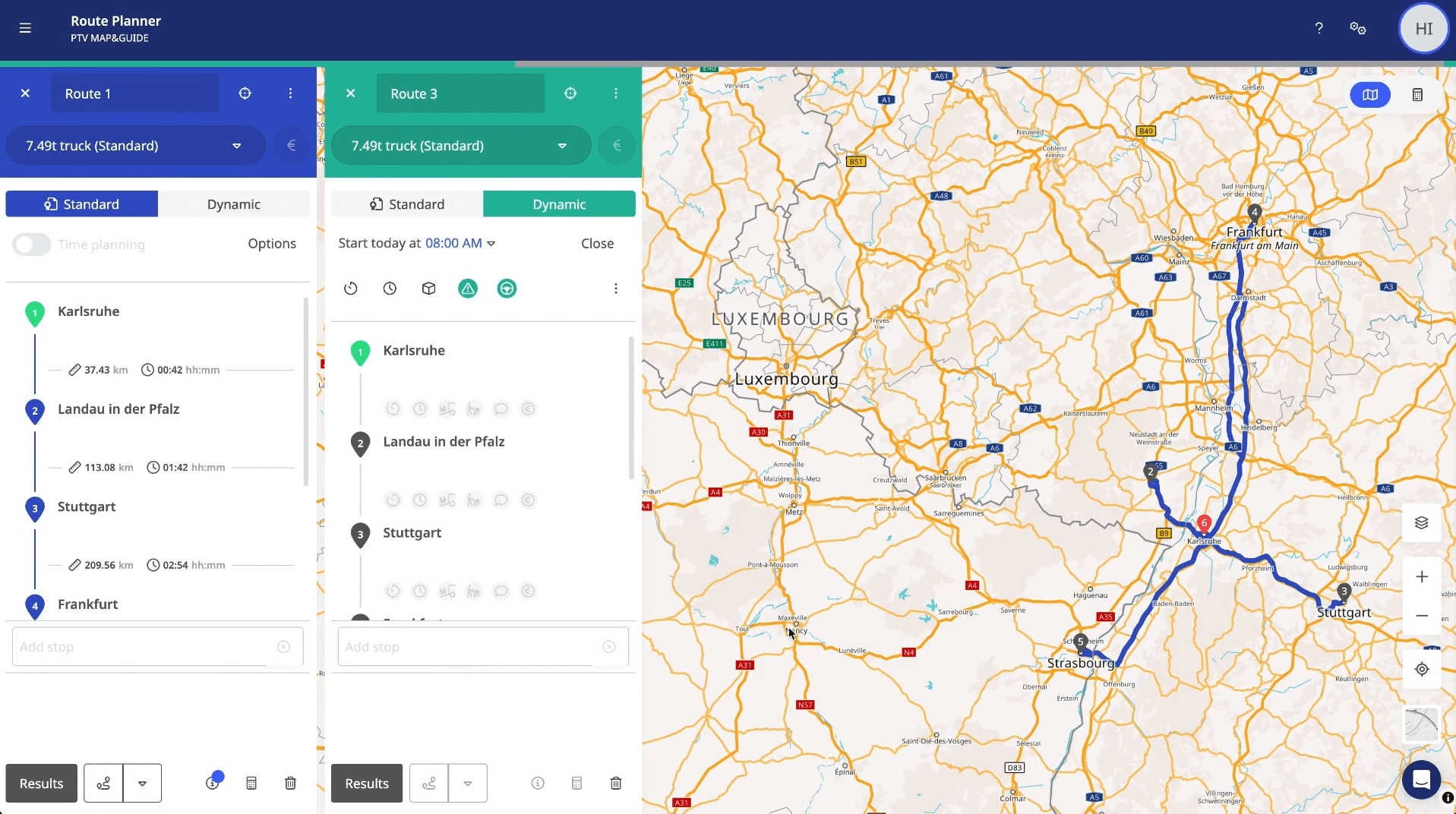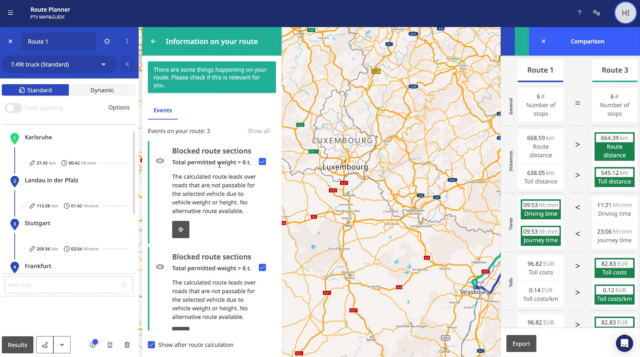Balancing Flexibility with Reliability
In the logistics and transport industry, agility and precision are key to maintaining efficiency and meeting customer demands. However, striking a balance between flexible, real-time route optimization and the stability required for contract negotiations is crucial for any business. This is where PTV Map&Guide excels, offering both Dynamic Routing for responsive route planning and Static Routing to support stable, reliable negotiations.
Let’s dive into the benefits of each approach and how they can work together to enhance your operations. Also discover why you shouldn’t use Google Maps for truck route planning.
What is Dynamic Routing?
Dynamic routing is the practice of creating flexible routes that adapt to real-world conditions. Unlike static routes, which are fixed and do not account for changes once set, dynamic routes leverage real-time data such as traffic conditions, road restrictions, and updated delivery requirements to continually optimize the path.
In PTV Map&Guide, dynamic routing helps logistics professionals respond swiftly to on-the-ground changes, ensuring efficient, up-to-date routing for vehicles and cargo.
The benefits of Dynamic Routing in PTV Map&Guide
Real-Time Traffic Management
Dynamic routing considers current traffic conditions, helping vehicles avoid congestion and delays. This capability allows for on-time deliveries and minimized fuel consumption, making it easier to stick to your schedules.
Compliance with Road Restrictions
By automatically accounting for factors like road width, height restrictions, weight limits, and environmental zones, dynamic routing ensures that your vehicles remain compliant and take the most efficient routes.
You can get started with dynamic routing easily in PTV Map&Guide. Simply set your route parameters, input your stops, and let the software do the heavy lifting by recalculating the most efficient route based on your specific needs.
The Foundation: Static Routing and its Importance in Negotiations
While dynamic routing offers flexibility for day-to-day operations, static routing plays a vital role in the bigger picture. Static routing involves pre-planned, fixed routes that do not change based on real-time conditions. This method is particularly important for companies involved in negotiating prices and contracts, where stability and predictability are key.
Why Static Routing is Crucial
- Reliability for Long-Term Planning Static routes form a reliable foundation for planning transport costs and timelines. When negotiating contracts with customers or partners, having a consistent route plan allows you to present accurate pricing, service commitments, and delivery expectations.
- Transparency in Cost Estimation Since static routes don’t vary, they allow businesses to more accurately calculate costs related to distance, fuel consumption, and time. This transparency is essential for establishing long-term agreements and ensuring that all parties involved have a clear understanding of the expected service levels.
- Stable Basis for Agreements Static routing provides a consistent framework for companies to develop transport strategies and make informed decisions about partnerships and pricing structures. This reliability builds trust and confidence, making contract negotiations smoother and more effective.
PTV Map&Guide makes static route planning just as easy as dynamic routing. By setting fixed routes with predetermined parameters, businesses can establish a strong baseline for negotiations, contract planning, and long-term logistical decisions.
Finding the right balance
While dynamic routing is crucial for day-to-day flexibility and efficient trip management, static routing provides the stable foundation necessary for reliable planning and effective negotiations. By utilizing both approaches within PTV Map&Guide, transport planners can achieve the best of both worlds—flexible, real-time adjustments for daily operations, and dependable, consistent routes for long-term agreements and cost estimations.
Get started with PTV Map&Guide
Whether your focus is on optimizing routes dynamically in response to changing conditions or establishing static routes for reliable negotiation, PTV Map&Guide has you covered. Sign up for a free trial to explore how both static and dynamic routing can elevate your route planning and strengthen your business. For detailed instructions on using these features, check out our online help on routing settings and route creation.

